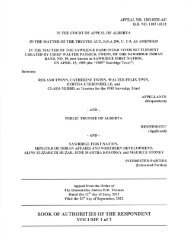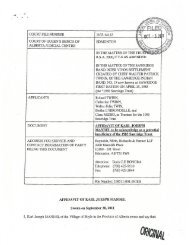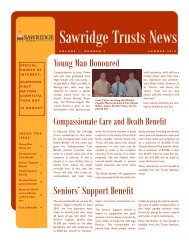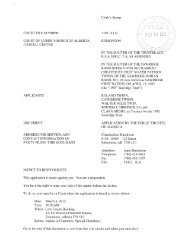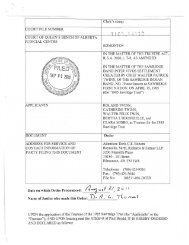31420-12-1 SAWRIDGE, Indian vs. ROLAND, Twinn et al
31420-12-1 SAWRIDGE, Indian vs. ROLAND, Twinn et al
31420-12-1 SAWRIDGE, Indian vs. ROLAND, Twinn et al
You also want an ePaper? Increase the reach of your titles
YUMPU automatically turns print PDFs into web optimized ePapers that Google loves.
F35<br />
1 that they have. And I’ll just briefly review the facts with you of that case because I think<br />
2 they’re important and I think they’re quite distinguishable from the scenario you have<br />
3 before you. Garden River was a situation where the Garden River Band s<strong>et</strong>tled a land<br />
4 claim, and arising out of that, they declared a per capita distribution of $1 million. And<br />
5 they passed a band council resolution to that effect in September of 1987. Subsequent to<br />
6 that, they had a me<strong>et</strong>ing and they decided that they were going to distribute these moneys<br />
7 tothe membership in December of 1987. And at the time of the distribution, there were a<br />
8 number of children of band members who were not y<strong>et</strong> members of the band. These<br />
9 children were children of what I will c<strong>al</strong>l C-31 members. And of course these would<br />
10 have been children of <strong>Indian</strong> women who lost their membership, and of course the<br />
11 children themselves would not have had any membership. The requirement at that time<br />
<strong>12</strong> was for the first generation to become a member of a band, they had to first g<strong>et</strong> their<br />
13 status back, their <strong>Indian</strong> status back. And with respect to this particular band, they had a<br />
14 membership code that required the children then to apply for membership, and then they<br />
15 would become members. The problem was that there was a backlog with the feder<strong>al</strong><br />
16 government with respect to g<strong>et</strong>ting the <strong>Indian</strong> status back. And as such, at the time of the<br />
17 distribution in December, these children were not y<strong>et</strong> members even though the chief and<br />
18 council at the time knew that ultimately they would become members. And in fact, they<br />
19<br />
20<br />
did become members subsequent to the date of the distribution.<br />
21 The Ontario Court of Appe<strong>al</strong> there d<strong>et</strong>ermined that in those circumstances the trustees had<br />
22 a duty -- well, first of <strong>al</strong>l, they found that the chief and council, by declaring a per capita<br />
23 distribution, that resulted in a trust and that they were now holding these funds in trust for<br />
24 the members of the band. The Ontario Court of Appe<strong>al</strong> then found that as trustees there<br />
25 was an obligation on the trustees to ascertain the beneficiaries. And the court found that<br />
26 when the band distributed the funds, they did so by choosing an arbitrary deadline. And<br />
27 it was that decision to arbitrarily decide that these funds would be distributed in December<br />
28 that caused the court some great concern. And ultimately, the court found that the<br />
29 trustees did not me<strong>et</strong> their obligation and that these minor -- these children were entitled<br />
30<br />
31<br />
to their proceeds.<br />
32 Now, the Public Trustee in this matter argues that trustees have a duty to make reasonable<br />
33 inquiries into the existence of beneficiaries and to identify and locate these beneficiaries.<br />
34 And in principle, we don’t take issue with the fact that a trustee has that obligation when<br />
35 it -- when it purports to act and to distribute funds. Our concern, however, is that that<br />
36 issue is not before this Court. There is no distribution before this Court that is being --<br />
37 that is being addressed, unlike the case in Garden River. Garden River, there was -- there<br />
38 was actu<strong>al</strong>ly a distribution, and then after the fact, the parties came to court and addressed<br />
39 wh<strong>et</strong>her the trustees m<strong>et</strong> their obligations at that time. Here, to go back to our advice and<br />
40 directions application, we’re coming to court simply to d<strong>et</strong>ermine wh<strong>et</strong>her the definition<br />
41 of beneficiary is contrary to public policy or not. And if so, should it be changed? It has



